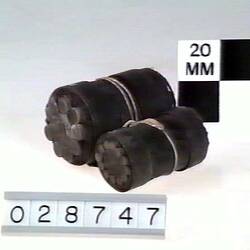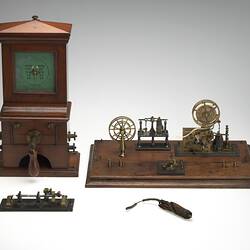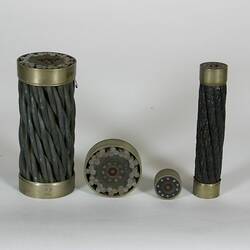Summary
Section of the deep-sea portion of the Atlantic Submarine Telegraph cable laid in 1857-1858.
The first attempt to lay a trans-Atlantic submarine telegraph cable took place in 1857 but failed when the cable broke after about 330 nautical miles had been laid. A second attempt in 1858 was successful but the cable operated for only about a month before failing.
The core of the cable was manufactured by the Gutta-Percha Company of London. One half of the length of the cable's outer sheathing was manufactured by R. S. Newall and Company, and the other half by Glass, Elliot & Co. The two manufacturers applied the sheathing strands with opposite lays -right-hand lay in the case of the Newall cable - and this caused problems when the cable had to be joined in mid-ocean. The sheathing strands in this sample have a right-hand lay so this sample is probably from the Newall cable.
In 1865 another attempt to lay a trans-Atlantic cable of improved design failed. Finally, in 1866 a cable was successfully laid. In addition, the 1865 cable was retrieved, repaired and completed so that there were two cables in operation by the end of 1866.
Physical Description
This piece of cable is a sample of the deep-sea section of the 1857/58 Atlantic submarine telegraph cable. Each end of the sample is fitted with a circumferential metal band. The description below is based on that in the book "Submarine telegraphs : their history, construction, and working ", by Charles Bright (London : Crosby Lockwood, 1898). The conductor at the centre of the cable was a strand of seven copper wires, each of No. 22 BWG (Birmingham Wire Gauge), or 0.71 mm diameter. The conductor was covered with three layers of gutta percha to a diameter of No. 00 BWG (9.65 mm) thus forming the core of the cable. The core was covered with a serving of hemp saturated with a mixture of Stockholm tar, pitch, linseed oil and wax. It was then sheathed with 18 strands each made up of seven iron wires of No. 22 BWG (a diameter of 0.71 mm). The sheathing strands were applied with a right-hand lay.
Significance
This cable sample shows the structure of the deep-sea portion of the Atlantic Submarine Telegraph cable laid in 1857/58. This cable was the first to carry telegraph messages across the Atlantic between Ireland and Newfoundland as part of the telegraph link between England and the USA.
The first attempt to lay a trans-Atlantic submarine telegraph cable took place in 1857 but failed when the cable broke after about 330 nautical miles had been laid. A second attempt in 1858 was successful but the cable operated for only about a month before failing.
More Information
-
Collection Names
-
Collecting Areas
-
Acquisition Information
Donation from Mr Hyslop
-
Manufacturer
-
Manufacturer (Probable)
R.S. Newall & Co, Gateshead-upon-Tyne, England, Great Britain, 1856
-
Past Owner
-
Classification
-
Category
-
Discipline
-
Type of item
-
Overall Dimensions
99 mm (Length), 19 mm (Outside Diameter)
Diameter is measured across circumferential end bands.
-
References
"Submarine telegraphs : their history, construction, and working ", by Charles Bright (London : Crosby Lockwood, 1898)
-
Keywords






